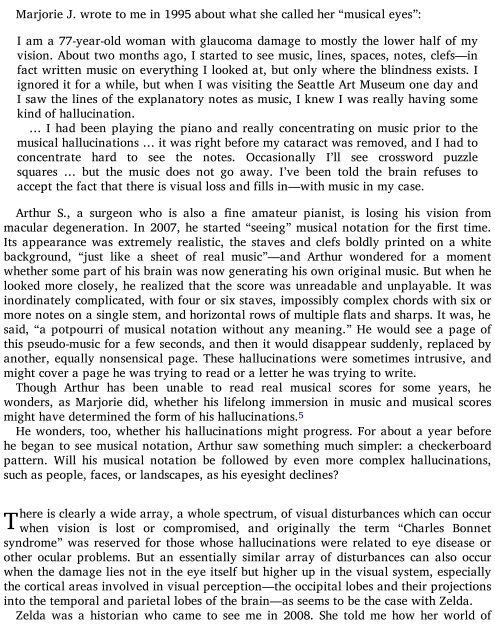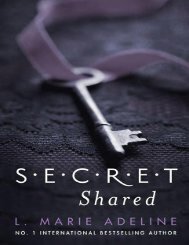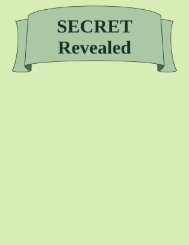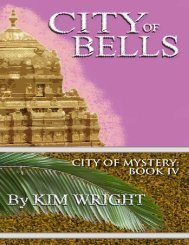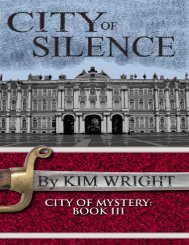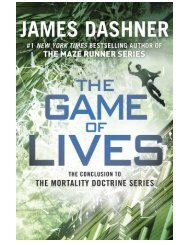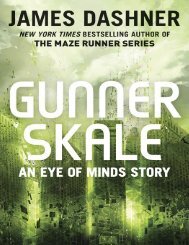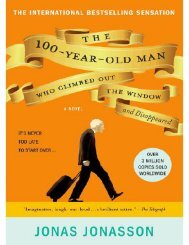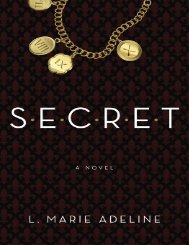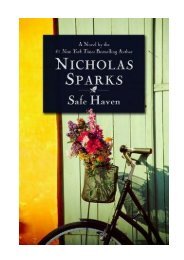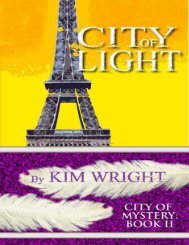32896589326509350
You also want an ePaper? Increase the reach of your titles
YUMPU automatically turns print PDFs into web optimized ePapers that Google loves.
Marjorie J. wrote to me in 1995 about what she called her “musical eyes”:<br />
I am a 77-year-old woman with glaucoma damage to mostly the lower half of my<br />
vision. About two months ago, I started to see music, lines, spaces, notes, clefs—in<br />
fact written music on everything I looked at, but only where the blindness exists. I<br />
ignored it for a while, but when I was visiting the Seattle Art Museum one day and<br />
I saw the lines of the explanatory notes as music, I knew I was really having some<br />
kind of hallucination.<br />
… I had been playing the piano and really concentrating on music prior to the<br />
musical hallucinations … it was right before my cataract was removed, and I had to<br />
concentrate hard to see the notes. Occasionally I’ll see crossword puzzle<br />
squares … but the music does not go away. I’ve been told the brain refuses to<br />
accept the fact that there is visual loss and fills in—with music in my case.<br />
Arthur S., a surgeon who is also a ne amateur pianist, is losing his vision from<br />
macular degeneration. In 2007, he started “seeing” musical notation for the rst time.<br />
Its appearance was extremely realistic, the staves and clefs boldly printed on a white<br />
background, “just like a sheet of real music”—and Arthur wondered for a moment<br />
whether some part of his brain was now generating his own original music. But when he<br />
looked more closely, he realized that the score was unreadable and unplayable. It was<br />
inordinately complicated, with four or six staves, impossibly complex chords with six or<br />
more notes on a single stem, and horizontal rows of multiple ats and sharps. It was, he<br />
said, “a potpourri of musical notation without any meaning.” He would see a page of<br />
this pseudo-music for a few seconds, and then it would disappear suddenly, replaced by<br />
another, equally nonsensical page. These hallucinations were sometimes intrusive, and<br />
might cover a page he was trying to read or a letter he was trying to write.<br />
Though Arthur has been unable to read real musical scores for some years, he<br />
wonders, as Marjorie did, whether his lifelong immersion in music and musical scores<br />
might have determined the form of his hallucinations. 5<br />
He wonders, too, whether his hallucinations might progress. For about a year before<br />
he began to see musical notation, Arthur saw something much simpler: a checkerboard<br />
pattern. Will his musical notation be followed by even more complex hallucinations,<br />
such as people, faces, or landscapes, as his eyesight declines?<br />
T<br />
here is clearly a wide array, a whole spectrum, of visual disturbances which can occur<br />
when vision is lost or compromised, and originally the term “Charles Bonnet<br />
syndrome” was reserved for those whose hallucinations were related to eye disease or<br />
other ocular problems. But an essentially similar array of disturbances can also occur<br />
when the damage lies not in the eye itself but higher up in the visual system, especially<br />
the cortical areas involved in visual perception—the occipital lobes and their projections<br />
into the temporal and parietal lobes of the brain—as seems to be the case with Zelda.<br />
Zelda was a historian who came to see me in 2008. She told me how her world of


